3.092 - AMICOR (25)
No dia 09/07, estamos a 65 anos de nosso casamento (1957). Há um ano passado do falecimento dela, encerrando um convívio de 70 anos, - pouco mais de um dia depois que ela havia completado 90
anos de uma vida bem vivida, deixando muito amor, amizades, admiradores, clientes, alunos e colegas.
Encerro aqui o ciclo no qual sempre abri o blog AMICOR com uma imagem dela.
#Dra. Valderês Antonietta Robinson Achutti (*13/06/1931+15/06/2021)

(clicar em Apresentação de Slides)
#NASA

James Webb Space Tele
The result – using 72 exposures over 32 hours – is among the deepest images of the universe ever taken, according to Webb scientists.
The James Webb Space Telescope won’t release its first full-colour science images until 12 July — but has just teased us with another mind-blowing calibration image. Webb scientists say the result — using 72 exposures over 32 hours — is among the deepest images of the universe ever taken.

This Fine Guidance Sensor test image was acquired in parallel with NIRCam imaging of the star HD147980 over a period of eight days at the beginning of May. This engineering image represents a total of 32 hours of exposure time at several overlapping pointings of the Guider 2 channel. The observations were not optimized for detection of faint objects, but nevertheless the image captures extremely faint objects and is, for now, the deepest image of the infrared sky. The unfiltered wavelength response of the guider, from 0.6 to 5 micrometers, helps provide this extreme sensitivity. The image is mono-chromatic and is displayed in false color with white-yellow-orange-red representing the progression from brightest to dimmest. The bright star (at 9.3 magnitude) on the right hand edge is 2MASS 16235798+2826079. There are only a handful of stars in this image – distinguished by their diffraction spikes. The rest of the objects are thousands of faint galaxies, some in the nearby universe, but many, many more in the distant universe. Credit: NASA, CSA, and FGS team.......#Science
 | (Getty Images) |
July's full moon — nicknamed the Buck Moon — will charge across Earth's skies on Wednesday, July 13. The moon will reach its peak at about 2:38 p.m. EDT (18:38 UTC) on Wednesday, but the Buck doesn't stop here; the moon will appear bright and full on Tuesday and Thursday night (July 12 and July 14), as well.
Avid skywatchers may notice that the moon looks even larger and brighter than normal. That's because, for the third month in a row, the full moon will rise as a supermoon — or a full moon that occurs while the moon is around or at its closest point to Earth, also known as its perigee. This month, the moon reaches perigee at about 5 a.m. EDT (09:00 UTC) on July 13, just 10 hours before the full moon rises. Full Story: Live Science (7/7) #Fronteiras do Pensamento |
|
#JAMAORIGINAL INVESTIGATION
Changes in the Relationship Between Income and Life Expectancy Before and During the COVID-19 Pandemic, California, 2015-2021Hannes Schwandt, PhD; Janet Currie, PhD; Till von Wachter, PhD; et al.
Conclusions and Relevance This retrospective analysis of census tract–level income and mortality data in California from 2015 to 2021 demonstrated a decrease in life expectancy in both 2020 and 2021 and an increase in the life expectancy gap by income level relative to the prepandemic period that disproportionately affected some racial and ethnic minority populations. Inferences at the individual level are limited by the ecological nature of the study, and the generalizability of the findings outside of California are unknown.
#
|
So Far This Season on
The Joy of Why PodcastExplore the first eight episodes of Quanta’s newest podcast hosted by Steven Strogatz.
New episodes premiere every other Thursday wherever you get your podcasts. |
|
|
|
|
PUBLISHED BY THE BERGGRUEN INSTITUTE
The United States Is On A Bleak Trajectory
Will American democracy commit suicide like all others before it?
Nathan Gardels, Noema Editor-in-Chief
At the end of June in Madrid, America led what was once considered a brain-dead NATO to newfound unity in the defense of democracies against an aggressive Russia and “the challenge of China.” In those very days, back home, the place was coming apart.
Hearings in the U.S. Congress revealed stunning details of the Jan. 6, 2021, assault on the Capitol aimed at overturning Donald Trump’s defeat at the polls, including the former president’s awareness that some of the mob were armed. Then the U.S. Supreme Court unleashed a series of rulings that came down to regulating a person’s private space (women’s bodies) while deregulating public space (guns, climate)./.../





















No comments:
Post a Comment